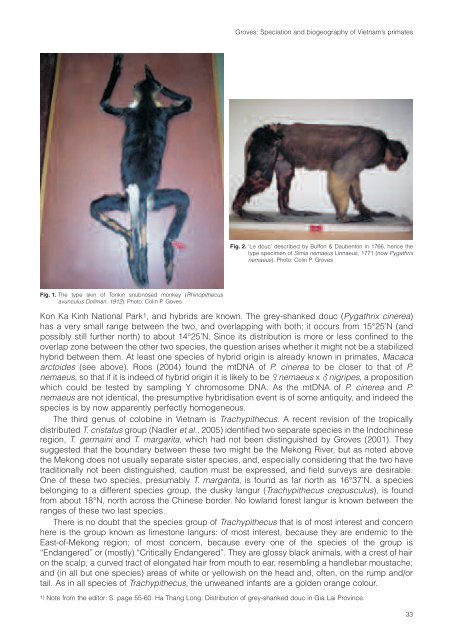Vietnamese Journal of Primatology - Frankfurt Zoological Society
Vietnamese Journal of Primatology - Frankfurt Zoological Society
Vietnamese Journal of Primatology - Frankfurt Zoological Society
Create successful ePaper yourself
Turn your PDF publications into a flip-book with our unique Google optimized e-Paper software.
Fig. 1. The type skin <strong>of</strong> Tonkin snubnosed monkey (Rhinopithecus<br />
avunculus Dollman, 1912). Photo: Colin P. Goves<br />
Groves: Speciation and biogeography <strong>of</strong> Vietnam’s primates<br />
Fig. 2. ‘Le douc’ described by Buffon & Daubenton in 1766, hence the<br />
type specimen <strong>of</strong> Simia nemaeus Linnaeus, 1771 (now Pygathrix<br />
nemaeus). Photo: Colin P. Groves<br />
Kon Ka Kinh National Park1, and hybrids are known. The grey-shanked douc (Pygathrix cinerea)<br />
has a very small range between the two, and overlapping with both; it occurs from 15°25’N (and<br />
possibly still further north) to about 14°25’N. Since its distribution is more or less confined to the<br />
overlap zone between the other two species, the question arises whether it might not be a stabilized<br />
hybrid between them. At least one species <strong>of</strong> hybrid origin is already known in primates, Macaca<br />
arctoides (see above). Roos (2004) found the mtDNA <strong>of</strong> P. cinerea to be closer to that <strong>of</strong> P.<br />
nemaeus, so that if it is indeed <strong>of</strong> hybrid origin it is likely to be nemaeus x nigripes, a proposition<br />
which could be tested by sampling Y chromosome DNA. As the mtDNA <strong>of</strong> P. cinerea and P.<br />
nemaeus are not identical, the presumptive hybridisation event is <strong>of</strong> some antiquity, and indeed the<br />
species is by now apparently perfectly homogeneous.<br />
The third genus <strong>of</strong> colobine in Vietnam is Trachypithecus. A recent revision <strong>of</strong> the tropically<br />
distributed T. cristatus group (Nadler et al., 2005) identified two separate species in the Indochinese<br />
region, T. germaini and T. margarita, which had not been distinguished by Groves (2001). They<br />
suggested that the boundary between these two might be the Mekong River, but as noted above<br />
the Mekong does not usually separate sister species, and, especially considering that the two have<br />
traditionally not been distinguished, caution must be expressed, and field surveys are desirable.<br />
One <strong>of</strong> these two species, presumably T. margarita, is found as far north as 16°37’N. a species<br />
belonging to a different species group, the dusky langur (Trachypithecus crepusculus), is found<br />
from about 18°N, north across the Chinese border. No lowland forest langur is known between the<br />
ranges <strong>of</strong> these two last species.<br />
There is no doubt that the species group <strong>of</strong> Trachypithecus that is <strong>of</strong> most interest and concern<br />
here is the group known as limestone langurs: <strong>of</strong> most interest, because they are endemic to the<br />
East-<strong>of</strong>-Mekong region; <strong>of</strong> most concern, because every one <strong>of</strong> the species <strong>of</strong> the group is<br />
“Endangered” or (mostly) “Critically Endangered”. They are glossy black animals, with a crest <strong>of</strong> hair<br />
on the scalp; a curved tract <strong>of</strong> elongated hair from mouth to ear, resembling a handlebar moustache;<br />
and (in all but one species) areas <strong>of</strong> white or yellowish on the head and, <strong>of</strong>ten, on the rump and/or<br />
tail. As in all species <strong>of</strong> Trachypithecus, the unweaned infants are a golden orange colour.<br />
1) Note from the editor: S. page 55-60: Ha Thang Long: Distribution <strong>of</strong> grey-shanked douc in Gia Lai Province.<br />
33
















